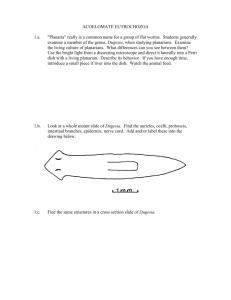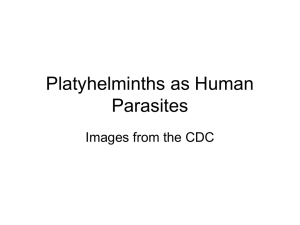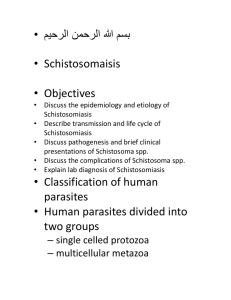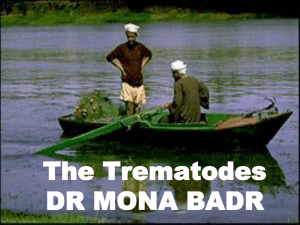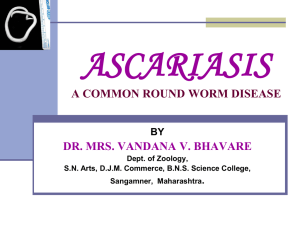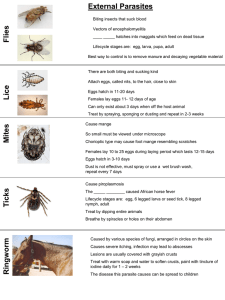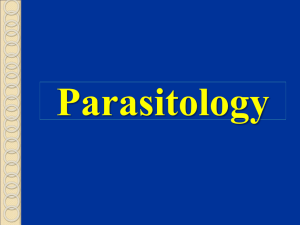MCQ exam in Cestoda
advertisement
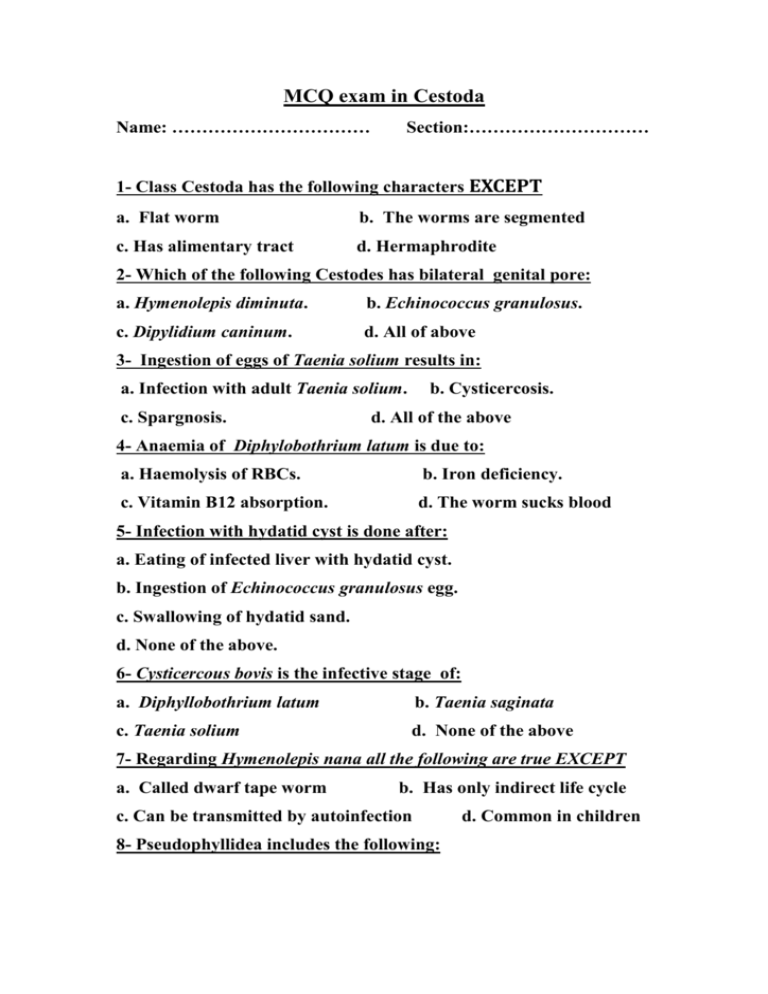
MCQ exam in Cestoda Name: …………………………… Section:………………………… 1- Class Cestoda has the following characters EXCEPT a. Flat worm b. The worms are segmented c. Has alimentary tract d. Hermaphrodite 2- Which of the following Cestodes has bilateral genital pore: a. Hymenolepis diminuta. b. Echinococcus granulosus. c. Dipylidium caninum. d. All of above 3- Ingestion of eggs of Taenia solium results in: a. Infection with adult Taenia solium. c. Spargnosis. b. Cysticercosis. d. All of the above 4- Anaemia of Diphylobothrium latum is due to: a. Haemolysis of RBCs. b. Iron deficiency. c. Vitamin B12 absorption. d. The worm sucks blood 5- Infection with hydatid cyst is done after: a. Eating of infected liver with hydatid cyst. b. Ingestion of Echinococcus granulosus egg. c. Swallowing of hydatid sand. d. None of the above. 6- Cysticercous bovis is the infective stage of: a. Diphyllobothrium latum b. Taenia saginata c. Taenia solium d. None of the above 7- Regarding Hymenolepis nana all the following are true EXCEPT a. Called dwarf tape worm b. Has only indirect life cycle c. Can be transmitted by autoinfection 8- Pseudophyllidea includes the following: d. Common in children a. Taenia species. b. Diphyllobithrium latum. C. Hymenolepis species. d. Dipylidium Caninum. Identify the following slides 9- ……………………………………….. 10 -………………………………………… (A) 1- Write the missing label of the given diagram 2- Mention content of the following egg diagram 3- Identify the following slide 4-All trematodes are hermaphrodite except: a. Fasciola spp. b. Heterophyes heterophyes. c. Schistosoma spp d. Dicrocelium dendriticum 5- The Lung fluke is Fasciolopsis hepatica. a. True b. False 6- Katayama syndrom may be caused by: a. Schistosome mansoni b. Schistosome japonicum c. Schistosome hematobium d. Both a &b 7- Metagonimus westermani differ from heterophes heterophes in: a. Position of ventral sucker b. Intermediate host c. Absent of genital sucker d. All of the above 8- A male farmer developed an attack of haematemesis together with Lower limb edema, splenomegaly and ascites He might have: a. Heterophyes heterophyes c. Fasciola hepatica b. Schistosoma mansoni d. all of the above 9- Infective stage of Heterophes Heterophes is: a. Egg b. Encysted metacercaria on grass c. Encysted metacercaria in fish muscle d. None of the above 10- Bulinus truncatus is the intermediate host of: a. Schistosoma haematobium c. Schistosoma japonicum. b. Schistosoma mansoni d. All of the above (B) 1- Write the missing label of the given diagram 2- Identify the following slides -I- - II - 3- Eggs of Heterophyes heterophyes differ from that of Fasciola in a. Colour. b. Size and shape c. Contents. d. All of the above. 4- Schistosme sp. Infection is through: a. Ingestion of egg with contamonated water b. Penetration of skin by cercaria c. Ingestion of miracidium d. Penetration of skin by miracidium 5- Which of the following Parasites is a blood fluke? a. Worms of the genus Fasciolopsis b. Worms of the genus Taenia c. Worms of the genus Schistosoma. d. Worms of the genus Heterophyes 6- Schistosoma is atypical trematode because: a. Eggs are non-opeerculated b. Sexes are separate. c. Have no redia stage. d. All of the above. 7- A male patient 30 years old from Korea developed the following : Fever, cough, haemoptysis, anorexia and night sweats since 2 months. He probably has a. Metagonimus yokogawai. c. Dicrocelium dendriticum b. Paragonimus westermani. d. Fasciola hepatica 8-Which of the following is true: a.-Bulinus truncatus is IMH of Schistosoma mansoni b. Schistosma jabonicum is the most pathogenic sp.of schistosoma c. Schistosoma is an intestinal fluke d. Schistosoma japonicum is common in Egypt 9- The scientific name of the lancet fluke is? a. Metagonimus yokogawai. b. Paragonimus westermani. c. Dicrocelium dendriticum d. Fasciola hepatica 10- Non human Schistosome cercaria may cause: a. Swimmer’s itch b. Bather’s itch c. Cercarial dermatitis d. All of the above TREMATODA & CESTODA EXAM 1- Which of the following describe the infective stage of Fasciola: a- Encysted metacercaria on aquatic plants c- Leptocercus cercaria b- Adult Faciola in liver d- Encysted metacercaria on cattle meet 2- The definitive host of Echinocasmus perfoliatus is: a- Aquatic bird b- Fish eating animals c- Herbivorous animals d- Carnivorous animals 3- Family Paraphistomatidae is characterized by the following EXCEPT: a- Ventral sucker is situated near the posterior end of the body b. Presence of the pharynx and branched intestinal caeca c. The genital pore opens ventrally. d. Operculaed eggs 4- Echinostome cercaria is: a. Leptocercous cercaria with highly pigmented body b. Leptocercous cercaria with a collar of hooks c. Cercaria with antetior stylet d. Cercaria with forked tail 5- Rumen is the habitat of all the following EXCEPT a. Paramphisomum cervi c. Carmyrius gregarius b. Cotylophoron cotylophorum d. Gastrodiscus aegyptiacus 6- Pernicious anaemia resulted from infection of Diphyllobothrium lautm is due to: a. Tendency of the worm to pick up vitamin B12 b. Absorption of unsaturated fatty acid liberated by the worm c. Both a &b d. Non of above 7- Spargnosis is caused by he following EXCEPT: a. Eating frog with plerocercoid. b. Drinking water with infected Cyclops c. Eating infected fish with plerocercoid. d. Use of frogs containing as Poultice 8- which of the following is correct: a. Coneurus serialis is the larval stage of Multiceps serialis. b. Coneurus cerebralis is the larval stage of Multiceps multiceps. c. Hydatid cyst is the larval stage of Echinococcus granulosus. d. All of the above. 9-Cysticercosis is caused by ingestion of : a. Cyclops containing procercoid. c. Cysticercus cellulosae. b. Cysticercus bovis. d. Taenia solium egg. 10- Larval stage of Taenia multiceps is: a.Cysticercous cellulosae b.Cysticercous bovi c.Coenurus cerebralis d.Coenurus serialis 11- Interproglottidal glands are present in the following EXCEPT a.Moniezia expansa b. Moniezia benedini c. Moniezia denticulata d. Moniezia trigonophora 12- Identify the samples 13- Identify the samples PROTZOA EXAM 1- Smear taken from the edge of oriental sore reveals: a. amastigote b. promastigote c. epimastigote d. trypomastigote 2- Ingestion of Entamoeba histolytica trophozoites causes: a. Amoebie gastritis. b. Amoebic duodenitis. c. Amoebic colitis. d. None of the above. 3- Toxoplasma gondii: a. Has both sexual & asexual phases in its life cycle. b. Releases oocysts by gametogony in intestinal epithelium of dog. c. Oocyst in stool is disporocystic tetrazoic. d. Unsporulated oocyst is an infective stage. 4- Black head disease caused by a. Cryptosporidium spp. b.Entamoeba histolytica. c. Balantidium coli. d. Histomonas meleagridis 5- All the following is/are Anterior station trypanosomes a. T. Congolense c. T. lewisi b. T. therileri. d. T. Cruzi 6- elongated sausage-shaped gametocyte partially encircle the host cell nucleus. Is the character of a. Haemoproteus columbae c. Plasmodium gallinacum 7- Identify the samples b. T. therileri. d. Histomonas meleagridis TREMATODA & CESTODA EXAM 1- Which of the following describe the infective stage of Fasciola: a- Encysted metacercaria on aquatic plants c- Leptocercus cercaria b- Adult Faciola in liver d- Encysted metacercaria on cattle meet 2- The definitive host of Echinocasmus perfoliatus is: a- Aquatic bird b- Fish eating animals c- Herbivorous animals d- Carnivorous animals 3- Family Paraphistomatidae is characterized by the following EXCEPT: a- Ventral sucker is situated near the posterior end of the body b. Presence of the pharynx and branched intestinal caeca c. The genital pore opens ventrally. d. Operculaed eggs 4- Echinostome cercaria is: a. Leptocercous cercaria with highly pigmented body b. Leptocercous cercaria with a collar of hooks c. Cercaria with antetior stylet d. Cercaria with forked tail 5- Rumen is the habitat of all the following EXCEPT a. Paramphisomum cervi c. Carmyrius gregarius b. Cotylophoron cotylophorum d. Gastrodiscus aegyptiacus 6- Pernicious anaemia resulted from infection of Diphyllobothrium lautm is due to: a. Tendency of the worm to pick up vitamin B12 b. Absorption of unsaturated fatty acid liberated by the worm c. Both a &b d. Non of above 7- Spargnosis is caused by he following EXCEPT: a. Eating frog with plerocercoid. b. Drinking water with infected Cyclops c. Eating infected fish with plerocercoid. d. Use of frogs containing as Poultice 8- which of the following is correct: a. Coneurus serialis is the larval stage of Multiceps serialis. b. Coneurus cerebralis is the larval stage of Multiceps multiceps. c. Hydatid cyst is the larval stage of Echinococcus granulosus. d. All of the above. 9-Cysticercosis is caused by ingestion of : a. Cyclops containing procercoid. c. Cysticercus cellulosae. b. Cysticercus bovis. d. Taenia solium egg. 10- Larval stage of Taenia multiceps is: a.Cysticercous cellulosae b.Cysticercous bovi c.Coenurus cerebralis d.Coenurus serialis 11- Interproglottidal glands are present in the following EXCEPT a.Moniezia expansa b. Moniezia benedini c. Moniezia denticulata d. Moniezia trigonophora 12- Identify the samples 13- Identify the samples MCQ exam in Trematodes: Student name: section: 1- Which of the following Parasites is a blood fluke? a) Worms of the genus Fasciolopsis b) Worms of the genus Paragonimus c) Worms of the genus Schistosoma. d) Worms of the genus Heterophyes 2- Redia stage is absent in? a) Fasciola sp. b) Schistosoma sp. c) Heterophyes heterophyes d) Metagonimus yokogawi 3- Microcercous cercaria is the cercaria of ? a) Fasciola sp. b) Schistosoma sp. c) Heterophyes heterophyes d) Paragonimus westermani 4- Habitat of Fasciolopsis buski is a) The liver b) The lung c) Large intestine d) Small intestine 5- The intermediate host of Fasciolopsis buski is snail belonging to the genus a) Lymnaea b)Pirenella c) Bulinus d) Segmentina 6- Diagnosis of Schistosoma haematobium can be done by a) Finding the characteristic egg in urine b) The use of nucleopore c) Hatching technique d) All of the above 7- Viable Schistosoma eggs have the following characters EXCEPT a) Egg is surrounded by R.B.Cs b) Opaque c) Miracidium seen d) Hatch on addition of fresh water 8- The most dangerous of Schistosoma sp. is a) Schistosoma haematobium b) Schistosoma mansoni c) Schistosoma japonicum d) all of the above 9- Identify the following slide: ………………………………. 10- Identify the following slide …………………………… 1-Heliminths of class Nematoda are characterized by the following EXCEPT: (a) Parasitic as well as free living. (b) Females usually shorter and thinner than males. (c) Males has ventrally curved posterior end. (d) Have mouth and anus. 2- Loeffler’s syndrome is due to: (a) Adult Ascaris worms in the intestine. (b) Migration of adult Ascaris to ectopic foci. (c) Inflammatory reaction in the lung due to Ascaris larva. (d) Sensitization against Ascaris antigen. 3- Strongyloides stercoralis infect man through: (a) Ingestion of embryonated eggs. (b) Penetration of the skin by rhabiditiform larvae. (c) Penetration of the skin by filariform larvae. (d) None of the above. 4- Visceral larva migrans is due to: (a) Ingestion of embryonated Ascaris lumbricoides eggs. (b) Ingestion of embryonated Ascaris eggs of dog and cat. (c) Skin penetration by Ancylstoma duodenale larvae. (d) Skin penetration by Necator americanus larvae. 5- Bachman’s test used in diagnosis of: (a) Ancylstomiasis. (b) Trichinosis. (c) Strongyloidosis. (d) Trichostrongyliasis. 6- Mazzotti test used for diagnosis of: a. Dracunculus medinensis. b. Human dirofilariasis. c. Onchocercosis. d. Enterobiasis 7- Which of the following nematodes has an intermediate host: a. Ascaris lumbricoides b. Tricuris trichura. c. Enterobius vermicuralis. d. Non of the above. 8- Parasite(s) that transmited by autoinfection: a. Capillaria philippinensis. b. Wuchereria bancrofti. c. Srongyloides stercoralis. d. both a and c. 9- NIH swab is used for diagnosis of : a. Enterobius vermicuralis. b. Hook worms. c. Loa loa. d. Non of he above 10- Which of the following is not true regarding Trichocephalus trichiura. a. The habitat is large intestine b. May lead to appendices. c. Life cycle with migration. d. infective sage is embryonated egg. 1-Microcytic hypochromic anaemia is caused by: a-Ascaris lumbricoides. b-Trichinella spiralis. c-Enterobius vermicularis. d-Anclystoma duodenale. 2-Cellular oesophogus charachterizing : a-Enterobius vermicularis. b-Ascaris lumbricoides. c-Trichochephalus trichuris. d-Anclystoma caninum. 3-Scotch adhesive tape is used for diagnosis of: a-Ascaris lumbricoides. b-Trichinella spiralis. c-Enterobius vermicularis. d-Trichinella spiralis 4-Which of the following parasites is facultative parasite: a-Trichochephalus trichuris. b-Trichinella spiralis. c-Strongyloides stercoralis. d-Ascaris lumbricoides. 5-Visceral larval migrans is caused by: a-Toxocara canis larva. b-Toxocara cati larva. c-Anclystoma caninum larva. d-Both a and b . 6- Creeping eruption is caused by larval invasion of: a- Ancylostoma caninum b- Ancylostoma braziliense c- both a & b d- non of the above 7- Which of the following needs intermediate host to complete its life cycle: a- Wuchereria bancrofti b- Brugia malayi c- Dracunculus medinesis d- all of the above 8-All the following statements are true except:a- Trichinella spiralis infects man by eating contaminated pork b- Wuchereria bancrofti microfilaria is of diurnal periodicity c- Ancylostoma duodenale is one of the bursated nematodes d- Pea soup diarrhea caused by Strongyloides stercoralis 9- The egg of Enterobius vermicularis is characterized by a- Transparent b- planoconvex c- contains coiled larva d- all of the above 10- Hyperchromic anaemia is caused by:a- Enterobius vermicularis b- Strongyloides stercoralis c- Trichocephalus trichiura d- A & c Class Nematoda Multiple Choice Questions (1) Helminthes of class Nematoda are characterized by the followings except: 1- Parasitic as well as free living. 2- Females usually shorter and thinner than males. 3- Males has ventrally curved posterior end 4- Have mouth and anus. The correct answer: number (2) Feed back: the adult males of class Nematoda are usually shorter and thinner than females. (2) Which is correct for the esophagus of nematodes? 1- Double bulbed oesophagus belongs to Rhabditidae. 2- Simple club shaped oesophagus belong to Oxyuridae 3- Cellular oesophagus belongs to Ascaridea. 4- Cylindrical oesophagus belongs to Filariidae. The correct answer: number (4) Feed back: the cylindrical oesophagus is composed of two parts; a short muscular narrow anterior part and a long wide glandular posterior part. It belongs to filarial worms. (3) Infective stage of Ascaris lumbricoides is: 1- Unfertilized eggs. 2- Decorticated fertilized eggs. 3- Decorticated unfertilized eggs. 4- Fertilized egg with second stage larva. The correct answer: number (4). (4) Loeffler’s syndrome is due to: 1- Adult Ascaris worms in the intestine. 2- Migration of adult Ascaris to ectopic foci. 3- Inflammatory reaction in the lung due to Ascaris larva. 4- Synthetization against Ascaris antigen. The correct answer: number (3) Feedback: Loeffler’s syndrome is a pulmonary manifestation of peticheal hemorrhage and lobular verminous pneumonia due to migeration of Ascaris larvae in lung tissues. (5) The method most often used in diagnosis of ascariasis is: 1- Hatching-sedimentation method 2- Cellophane tape impression 3- Direct fecal smear 4- Sedimentation method 5- Therapeutically test. The correct answer: number (3) (6) Visceral larva migrans is due to: 1- Ingestion of embryonated Ascaris lumbricoides eggs. 2- Ingestion of embryonated Ascaris eggs of dog and cat. 3- Skin penetration by Ancylstoma duodenale larvae. 4- Skin penetration by Necator americanus larvae. The correct answer: number (1) Feed back: Visceral larva migrans is a condition produced by the presence of the larvae of ascarids of dogs and cats (Toxocara canis and Toxocara cati) in the tissues of unnatural host (man). (7) Visceral larva migrans is diagnosed by the followings except: 1- Biopsy from suspected organs. 2- ELISA. 3- Direct fecal smear. 4- Immunoblots. The correct answer: number (3) (8) Enterobius vermicularis may be found in: 1- Colon and caecom 2- Small intestine 3- Biliary tracts. 4- None of the above The correct answer: number (1) (9) Which of the following is correct for Enterobius vermicularis egg: 1- Plano-convex. 2- Opaque with double layer. 3- Have immature emberyo. 4- All of the above. The correct answer: number (1) (10)The mode of infection with pinworm is the following except: 1. Through mouth 2. Inhalation of air borne ova 3. Retroinfection 4. Infected larvae penetrate the skin The correct answer: number (4) (11) Perianal itching is due to: 1- Dead males of Enterobius vermicularis after fertilization. 2- Female Enterobius vermicularis lay eggs in perianal region. 3- Patient scratching the perianal region to relieve the itching. 4- Invasion of the infective larvae to the human skin. The correct answer: number (2) (12) The main symptoms of pinworm infection: 1- Anemia 2- Restlessness 3- Fever 4- Pruritus of perianal region. The correct answer: number (4) (13) The method most often used in diagnosis of pin worm is: 1- Hatching-sedimentation method 2- Cellophane tape impression 3- Direct fecal smear 4- Sedimentation method 5- Therapeutical test. The correct answer: number (2) Feed back: as Enterobius vermicularis eggs seldom seen in stool, the mostly used method in diagnosis is NIH swab or cellophane tape swab applied to the perianal region. (14)The chief morphological differences between Ancylostoma duodenale and Necator americanus in adult stage: 1- Presence of ventral teeth or cutting plates 2- Shape of bursa and division of dorsal ray 3- Shape of worm 4- Shape and arrangement of body nuclei The correct answer: number (1) (15) Ancylstoma duodenale is: 1. Hook worm. 2. Whip worm. 3. Seat worm. 4. Dwarf thread worm. The correct answer: number (1) (16)The location of hookworms is 1- Peripheral blood 2- Lymphatic system 3- Small intestine 4- Large intestine 5- Lung The correct answer: number (3) (17)Infective stage of Ancylstoma duodenale is: 1. Immature eggs. 2. Embryonated eggs. 3. Rhabditiform larvae. 4. Sheathed filariform larvae. The correct answer: number (4) (18) Ancylstoma duodenale infect man through: 1. Ingestion of embryonated eggs. 2. Penetration of the skin by rhabditiform larvae. 3. Penetration of the skin and mucous membrane of the mouth by the sheathed filariform larvae. 4. None of the above. The correct answer: number (3) (19) Loeffler’s syndrome is due to: 1. Ancylstoma duodenale. 2. Strongyloides stercoralis. 3. Ascaris lumbricoides. 4. All of the above. The correct answer: number (4) (20) Microcytic hypochromic anemia is caused by: 1. Ascaris lumbricoides. 2. Ancylostoma duodenale. 3. Enterobius vermicularis. 4. None of the above. The correct answer: number (2) (21)The method most often used in diagnosis of ancylostomiasis is 1- Direct fecal smear 2- Saturated brine flotation method 3- Hatching-sedimentation method 4- Cellophane tape impression The correct answer: number (1) (22)The facultative hook worm is: 1- Ancylstoma duodenale. 2- Strongyloides stercoralis. 3- Ascaris lumbricoides. 4- Necator americanus 5- None of the above. The correct answer: number (2) Feed back: Strongyloides stercoralis is considered a facultative parasite because it has direct cycle (parasitic generation) and indirect life cycle (free-living generation) according to the enviromental conditions. (23) Stongyloides stercoralis infect man through : 1- Ingestion of embryonated eggs. 2- Penetration of the skin by rhabiditiform larvae. 3- Penetration of the skin by filariform larvae. 4- None of the above. The correct answer: number (3) (24)Strongyloides stercoralis is: 1- A facultative parasite. 2- An ectoparasite. 3- An opportunistic parasite. 4- Both a & c. The correct answer: number (4) (25)One of the complications of Strongyloides stercoralis infection is: 1- Iron deficiency anemia 2- Ground itch 3- Pea soup diarrhea 4- Intestinal obstruction with heavy infestation. The correct answer: number (3) Feedback: in severe infection with Strongyloides stercoralis; intestinal irritation may occur resulting in diarrhea that is commonly known as pea soup diarrhea. (26) Cutaneous larva migrans is due to: 1- Larvae of Necator americanus 2- Larvae of Ancylstoma duodenale 3- Larvae of Ancylstoma caninum and A. brazilliense. 4- All of the above. The correct answer: number (3) (27)Creeping eruption is caused by the following except: 1- Cutaneous myiasis 2- Ground itch 3- Non- human filarial worms. 4- Filariform larvae of the dog and cat hookworms The correct answer: number (2) (28)Trichinella spiralis is a parasite of: 1- Man 2- Pig 3- Rat 4- All of above The correct answer: number (4) (29)Trichinosis in humans results from: 1- Ingestion of eggs 2- Ingestion of cyst 3- Ingestion of pork containing encysted larvae 4- Ingestion of pork containing cysticerci 5- Penetration of larvae through the skin The correct answer: number (3) (30) The most serious complication of trichinosis in human is: 1- Severe gastroenteritis 2- Encephalitis 3- Myocarditis and heart failure 4- All of the above. The correct answer: number (4) (31)Bachman’s test is intradermal test used in diagnosis of: 1- Ancylstomiasis 2- Trichinosis 3- Strongyloidosis 4- Trichostrongyliasis The correct answer: number (2) (32)The whipworms live in 1- Cecum 2- Small intestine 3- Bile duct of liver 4- Mesenteric veins 5- Lymphatic system The correct answer: number (1) (33)The time needed for Trichocephalus trichurus eggs to appear in stool after infection is: 1- 1-2 weeks. 2- 1-2 months 3- 3 months. 4- None of the above The correct answer: number (2) (34)The egg of Trichocephalus trichurus is: 1- Plano-convex 2- Brownish with a mucoid plugs at each pole. 3- mature with fully developed larva 4- All of the above. The correct answer: number (2) (35)Type of anemia in whipworm infection is: 1- Microcytic hypochromic anemia 2- Pernicious anemia 3- Haaemolytic anemia 4- All of the above 5- Both a and b The correct answer: number (5) (36)One of the methods of diagnosis for whipworm infection is: 1- Culture of larvae 2- Cellophane tape impression 3- Xenodiagnosis 4- Sigmoidoscopy. The correct answer: number (4) Feed back: Sigmoidoscopy can be done in whip worm infection where it shows the characteristic white bodies of adults hanging from inflamed mucosa (coconut cake rectum). (37)The mode of infection with Capillaria hepatica in human is: 1- Man eats an egg-burdened liver 2- Internal autoinfection 3- Ingestion of food or drink contaminated with embryonated eggs. 4- Eating raw or undercooked fish containing infective larvae. The correct answer: number (3) (38)The most serious complication Capillaria philippinensis is : 5- Hepatomegaly. 6- Electrolyte imbalance 7- Malabsorption syndrome. 8- Acute hepatitia. The correct answer: number (2) ﻜﻠﻴﺔ ﺍﻟﻁــﺏ ﻗﺴﻢ اﻟﻄﻔﯿﻠﯿﺎت MCQ exam in Trematodes Name: …………………………… Section:………………………… Identify the following slides 1- ……………………………………….. 2 -………………………………………… 3- Metagonimus westermani differs from Heterophyes heterophyes in: a. Position of ventral sucker c. Absence of genital sucker b. Intermediate host d. All of the above 4- Bulinus truncatus is the intermediate host of: a. Schistosoma haematobium b. Schistosoma mansoni c. Schistosoma japonicum. d. All of the above 5- The scientific name of the lancet fluke is? ﻜﻠﻴﺔ ﺍﻟﻁــﺏ ﻗﺴﻢ اﻟﻄﻔﯿﻠﯿﺎت b. Paragonimus westermani. a. Metagonimus yokogawai. c. Dicrocoelium dendriticum d. Fasciola hepatica 6- Non human Schistosoma cercaria may cause: a. Swimmer’s itch b. Bather’s itch c. Cercarial dermatitis d. All of the above 7- The habitat of the following parasites is small intestine EXCEPT: a. Heterophyes heterophyes b. Fasciolopsis buski. c. Paragonimus westermani. d. b & a. 8- Which of the following describe the infective stage of Fasciola: a- Encysted metacercaria on aquatic plants b- Adult Fasciola in liver c- Leptocercus cercaria d- Encysted metacercaria on cattle meat 9- Select the CORRECT statement: a. Fasciola eggs hatch in fresh water. b. Heterophyes heterophyes eggs hatch in brackish water. c. Schistosoma eggs are ingested by the snail intermediate host. d. All of the above. 10- All trematodes are hermaphrodite EXCEPT: a. Fasciola spp. c. Schistosoma sp. b. Heterophyes heterophyes. d. Dicrocoelium dendriticum ﻜﻠﻴﺔ ﺍﻟﻁــﺏ ﻗﺴﻢ اﻟﻄﻔﯿﻠﯿﺎت TREMATODES EXAM(MCQ) Student name: Section: 1- Which of the following parasites is a blood fluke? a) Worms of the genus Fasciolopsis b) Worms of the genus Paragonimus c) Worms of the genus Schistosoma. d) Worms of the genus Heterophyes 2- The following is true regarding Trematodes EXCEPT: a) All are hermaphrodites except Schistosoma. b) Without body cavity. c) They are ectoparasites. d) Commonly known as Flukes 3- The habitat of the following parasites is small intestine EXCEPT: a) Heterophyes heterophyes b) Fasciolopsis buski. c) Paragonimus westermani. d)Metagonimus yokagawi 4- Fasciola gigantica differs form F asciola hepatica in : a- Habitat in human body b- Needs of snail as an intermediate host c- Life cycle d- Size 5- The following are INCORRECT EXCEPT: a) The infective stage in paragonomiasis is the cercaria. b) Halzoun occurs after ingestion of raw liver. c) Metagonimus yokagawi is also called lung fluke. d) Fasciola hepatica inhabit the small intestine 6) Which of the following is the infective stage of Fasciola a- Encysted metacercaria on aquatic plants b- Adult Fasciola in liver c- Leptocercus cercaria d- Encysted metacercaria on cattle meat ﻜﻠﻴﺔ ﺍﻟﻁــﺏ ﻗﺴﻢ اﻟﻄﻔﯿﻠﯿﺎت 7) The following Trematodes lack redia stage: a- Schistosoma mansoni b- Paragonimus westermani c- Heterophyes heterophyes d- Fasciolopsis buski 8)All trematoda eggs are operculated EXCEPT? a) Fasciola sp. eggs b) Heterophyes heterophyes eggs c) Schistosoma sp. eggs d) Fasciolopsis buski eggs Identify the following slides 9)……………………… 10)…………………………… ﻜﻠﻴﺔ ﺍﻟﻁــﺏ ﻗﺴﻢ اﻟﻄﻔﯿﻠﯿﺎت Periodic exam of introduction & Cestoda Student name:.............................. Section:...................... 1)Cysticercosis is caused by ingestion of : a) Cyclops containing procercoid. b) Cysticercus bovis. c) Cysticercus cellulosae. d) Taenia solium egg. 2)The intermediate hosts of Diphyllobothrium latum is: a) Cyclops and cattle b) Snails and fish c) Pork and cattle d) Cyclops and fish 3)Infective stage in case of Taenia saginata is: a) Procercoid b) Plerocercoid c) Cysticercous cellulosae d) Cysticercous bovis 4) Blood transfusion can transmit: a) Malaria b) Leishmania c) Taenia d) Both a & b 5)The following parasite needs one intermediate host: a) Diphyllobothrium latum. b) Heterophyes heterophyes. c) Schistosoma haematobium. ﻜﻠﻴﺔ ﺍﻟﻁــﺏ ﻗﺴﻢ اﻟﻄﻔﯿﻠﯿﺎت d) None of the above. 6)Man acts as intermediate host and definitive host in: a) Taenia solium. b) Taenia saginata. c) Diphyllobohrium latum. d) None of the above. 7) Diagnose this case: 15 years old female with history of eating under cooked beef. Symptoms: - Diarrhea, abdominal pain. - Hunger feeling. -loss of weight and weakness. Investigations: - There is moderate eosinophilia. - Presence of gravid segments in stool and accidentally there were eggs appear by repeated stool examination. 8) Diagnose this case. 5 years old boy suffered from: - General weakness, abdominal pain, diarrhea, Loss of weight and loss of appetite. Investigatioins: By examination of the stool there were several oval eggs with 2 membranes, the inner membrane has two polar thickenings arise from each thickening 4-8 filaments. ﻜﻠﻴﺔ ﺍﻟﻁــﺏ ﻗﺴﻢ اﻟﻄﻔﯿﻠﯿﺎت Identify the sample ………………………………………)9 10)…………………………………. ﻜﻠﻴﺔ ﺍﻟﻁــﺏ ﻗﺴﻢ اﻟﻄﻔﯿﻠﯿﺎت Periodic exam of introduction & Cestoda Student name:.............................. Section:...................... 1)Cysticercosis is caused by ingestion of : a) Cyclops containing procercoid. b) Cysticercus bovis. c) Cysticercus cellulosae. d) Taenia solium egg. 2)The intermediate hosts of Diphyllobothrium latum is: a) Cyclops and cattle b) Snails and fish c) Pork and cattle d) Cyclops and fish 3)Infective stage in case of Taenia saginata is: a) Procercoid b) Plerocercoid c) Cysticercous cellulosae d) Cysticercous bovis 4) Blood transfusion can transmit: a) Malaria b) Leishmania c) Taenia d) Both a & b 5)The following parasite needs one intermediate host: a) Diphyllobothrium latum. b) Heterophyes heterophyes. c) Schistosoma haematobium. d) None of the above. 6)Man acts as intermediate host and definitive host in: a) Taenia solium. b) Taenia saginata. c) Diphyllobohrium latum. d) None of the above. ﻜﻠﻴﺔ ﺍﻟﻁــﺏ ﻗﺴﻢ اﻟﻄﻔﯿﻠﯿﺎت 7) Diagnose this case: 15 years old female with history of eating under cooked beef. Symptoms: - Diarrhea, abdominal pain. - Hunger feeling. -loss of weight and weakness. Investigations: - There is moderate eosinophilia. - Presence of gravid segments in stool and accidentally there were eggs appear by repeated stool examination. 8) Diagnose this case. 5 years old boy suffered from: - General weakness, abdominal pain, diarrhea, Loss of weight and loss of appetite. Investigatioins: By examination of the stool there were several oval eggs with 2 membranes, the inner membrane has two polar thickenings arise from each thickening 4-8 filaments.
